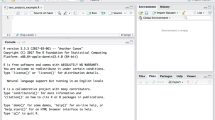Abstract
In this paper we discuss the tendencies infunctionality and technology of software for textanalysis and reflect on those areas where moredevelopment is needed. The basis for this discussionforms a comprehensive review of fifteen currentlyavailable software for text analysis (Alexa and Zuell,1999). In the review the following software packageswere individually presented in a detailed andextensive manner: AQUAD, ATLAS.ti, CoAn, Code-A-Text,DICTION, DIMAP-MCCA, HyperRESEARCH, KEDS,NUD*IST, QED, TATOE, TEXTPACK, TextSmart,WinMAXpro, and WordStat. Here we only delineate ourmethodology and criteria for selecting which programsto review and concentrate on discussing the types ofsupport the selected programs offer, the commonalitiesand differences of their functionality, point to someof their shortcomings and put forward suggestions forfuture development.
Similar content being viewed by others
References
Alexa, M. & Rostek, L. (1996). Computer-assisted, corpus-based analysis text with TATOE'. ALLC-ACH96, Book of Abstracts. Bergen, Norway, University of Bergen, pp. 11–17.
Alexa, M. & Zuell, C. (1999). Software for Computer-Assisted Text Analysis: A Review. ZUMA Nachrichten Spezial. Mannheim, Germany: ZUMA.
Alexa, M. & Schmidt, I. (1999). Modell einer mehrschichtigen Textannotation für die computerunterstützte Textanalyse. In W. Möhr & I. Schmidt (eds), SGML/XML - Anwendungen und Perspektiven. Heidelberg: Springer-Verlag.
Depuis, A. & Tornabene, E. (1993). HyperRESEARCHTM from ResearchWare: A Content Analysis Tool for the Qualitative Researcher. Randolph, MA: ResearchWare, Inc.
Evans, W. (1996). Computer-supported content analysis. Social Science Computer Review 114(3): 269–279.
Fielding, N. G. & Lee, R. M. (1991). Using Computers in Qualitative Research. Thousand Oaks, CA: Sage Publications.
Hart, R. P. (1985). Systemic analysis of political discourse: The development of DICTION. In: K. Sanders (eds), Political Communication Yearbook: 1984. Carbondale, IL: Southern Illinois University Press, pp. 97–134.
Huber, G. L. (1997). Analysis of Qualitative Data with AQUADFive for Windows. Schwangau, Germany: Ingeborg Huber.
Klein, H. (1997a). Classification of Text Analysis Software. In: R. Klar & O. Oppitz (eds), Classification and Knowledge Organization. Proceedings of the 20th Annual Conference of the Gesellschaft fuer Klassifikation e.V. Heidelberg: Springer, pp. 355–362.
Klein, H. (1997b). INTEXT-Handbuch, Version 4.0. Jena, Germany: Mimeo.
Kuckartz, U. (1998). WinMAX: Scientific Text Analysis for the Social Sciences. User's guide. Berlin: BSS.
Lezius, W., Rapp, R. & Wettler, M. (1998). A freely available morphological analyzer, disambiguator, and context sensitive lemmatizer for German. In: Proceedings of the COLING-ACL 1998, Canada.
McTavish, D. G. & Pirro E. B. (1990). Contextual content analysis. Quality and Quantity 24: 245–265.
McTavish, D., Litkowski K. C. & Schrader S. (1997). A computer content analysis approach to measuring social distance in residential organizations for older people. Social Science Computer Review 15(2): 170–180.
Miller, G. A., Beckwith, R., Fellbaum, Chr., Cross, D., Miller, K. & Tengi, R. (1993). Five papers on WordNetTM. CSL Report 43. Cognitive Science Laboratory. Princeton, NJ: Princeton University.
Mohler, P. Ph. & Zuell, C. (1998). TEXTPACK User's Guide. Mannheim: ZUMA.
Muhr, T. (1997). ATLAS.ti the Knowledge Workbench: Visual Qualitative Data AnalysisManagement Model Building. Short User's Manual (Version 4.1 for Windows 95 and Windows NT). Berlin: Scientific Software Development.
Muhr, Th. (1996). Textinterpretation und Theorienentwicklung mit Atlas/ti. In: W. Bos & C. Tarnai (eds), Computerunterstuetzte Inhaltsanalyse in den empirischen Sozialwissenschaften. Muenster: Waxmann, pp. 245–259.
Richards, L. (1998). NUD*IST Introductory Handbook. Victoria, Australia: QSR.
Roberts, C. W., ed. (1997). Text Analysis for the Social Sciences: Methods for Drawing Statistical Inferences from Texts and Transcripts. Mahwah, N.J.: Lawrence Erlbaum Assoc. Publishers.
Rostek, L. & Alexa, M. (1998). Marking up in TATOE and exporting to SGML. Computers and the Humanities 31: 311–326.
Schrodt, Ph. A. (1998). KEDS: Kansas Event Data System. Version 0.9B7. Kansas University: http://www.ukans.edu/~keds/.
Stone, Ph. J. (1997). Thematic text analysis: New agendas for analysing text content. In: C. W. Roberts (ed.), Text Analysis for the Social Sciences: Methods for Drawing Statistical Inferences from Texts and Transcripts. Mahwah, N.J.: Lawrence Erlbaum Assoc. Publishers, pp. 35–54.
Tesch, R. (1990). Qualitative Research: Analysis Types and Software Tools. New York: Falmer.
Tesch, R. (1991). Software for qualitative researchers: Analysis needs and program capabilities. In: N. G. Fielding and R. M. Lee (eds), Using Computers in Qualitative Research. Thousand Oaks, CA: Sage Publications.
TextSmartTM 1.0 (1997). User's Guide. Chicago: SPSS Inc.
Weitzman, E. A. & Miles, M. B. (1995). A Software Sourcebook: Computer Programs for Qualitative Data Analysis. Thousand Oaks, CA: Sage Publications.
Author information
Authors and Affiliations
Rights and permissions
About this article
Cite this article
Alexa, M., Zuell, C. Text Analysis Software: Commonalities, Differences and Limitations: The Results of a Review. Quality & Quantity 34, 299–321 (2000). https://doi.org/10.1023/A:1004740203542
Issue Date:
DOI: https://doi.org/10.1023/A:1004740203542



